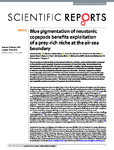Blue pigmentation of neustonic copepods benefits exploitation of a prey-rich niche at the air-sea boundary
| dc.contributor.author | Rahlff, J | |
| dc.contributor.author | Ribas-Ribas, M | |
| dc.contributor.author | Brown, SM | |
| dc.contributor.author | Mustaffa, NIH | |
| dc.contributor.author | Renz, J | |
| dc.contributor.author | Peck, MA | |
| dc.contributor.author | Bird, K | |
| dc.contributor.author | Cunliffe, M | |
| dc.contributor.author | Melkonian, K | |
| dc.contributor.author | Zappa, CJ | |
| dc.date.accessioned | 2020-06-20T08:58:49Z | |
| dc.date.issued | 2018-07-31 | |
| dc.identifier.issn | 2045-2322 | |
| dc.identifier.issn | 2045-2322 | |
| dc.identifier.other | 11510 | |
| dc.identifier.uri | http://hdl.handle.net/10026.1/15784 | |
| dc.description.abstract |
<jats:title>Abstract</jats:title><jats:p>The sea-surface microlayer (SML) at the air-sea interface is a distinct, under-studied habitat compared to the subsurface and copepods, important components of ocean food webs, have developed key adaptations to exploit this niche. By using automated SML sampling, high-throughput sequencing and unmanned aerial vehicles, we report on the distribution and abundance of pontellid copepods in relation to the unique biophysicochemical signature of the SML. We found copepods in the SML even during high exposure to sun-derived ultraviolet radiation and their abundance was significantly correlated to increased algal biomass. We additionally investigated the significance of the pontellids’ blue pigmentation and found that the reflectance peak of the blue pigment matched the water-leaving spectral radiance of the ocean surface. This feature could reduce high visibility at the air-sea boundary and potentially provide camouflage of copepods from their predators.</jats:p> | |
| dc.format.extent | 11510- | |
| dc.format.medium | Electronic | |
| dc.language | en | |
| dc.language.iso | en | |
| dc.publisher | Springer Science and Business Media LLC | |
| dc.subject | 3708 Oceanography | |
| dc.subject | 31 Biological Sciences | |
| dc.subject | 3103 Ecology | |
| dc.subject | 37 Earth Sciences | |
| dc.subject | 41 Environmental Sciences | |
| dc.subject | 14 Life Below Water | |
| dc.title | Blue pigmentation of neustonic copepods benefits exploitation of a prey-rich niche at the air-sea boundary | |
| dc.type | journal-article | |
| dc.type | Article | |
| plymouth.author-url | https://www.ncbi.nlm.nih.gov/pubmed/30065353 | |
| plymouth.issue | 1 | |
| plymouth.volume | 8 | |
| plymouth.publication-status | Published online | |
| plymouth.journal | Scientific Reports | |
| dc.identifier.doi | 10.1038/s41598-018-29869-7 | |
| plymouth.organisational-group | /Plymouth | |
| plymouth.organisational-group | /Plymouth/Faculty of Science and Engineering | |
| plymouth.organisational-group | /Plymouth/Faculty of Science and Engineering/School of Biological and Marine Sciences | |
| plymouth.organisational-group | /Plymouth/REF 2021 Researchers by UoA | |
| plymouth.organisational-group | /Plymouth/REF 2021 Researchers by UoA/UoA07 Earth Systems and Environmental Sciences | |
| plymouth.organisational-group | /Plymouth/Users by role | |
| plymouth.organisational-group | /Plymouth/Users by role/Academics | |
| dc.publisher.place | England | |
| dcterms.dateAccepted | 2018-07-19 | |
| dc.rights.embargodate | 2020-6-24 | |
| dc.identifier.eissn | 2045-2322 | |
| dc.rights.embargoperiod | Not known | |
| rioxxterms.versionofrecord | 10.1038/s41598-018-29869-7 | |
| rioxxterms.licenseref.uri | http://www.rioxx.net/licenses/all-rights-reserved | |
| rioxxterms.licenseref.startdate | 2018-07-31 | |
| rioxxterms.type | Journal Article/Review |


